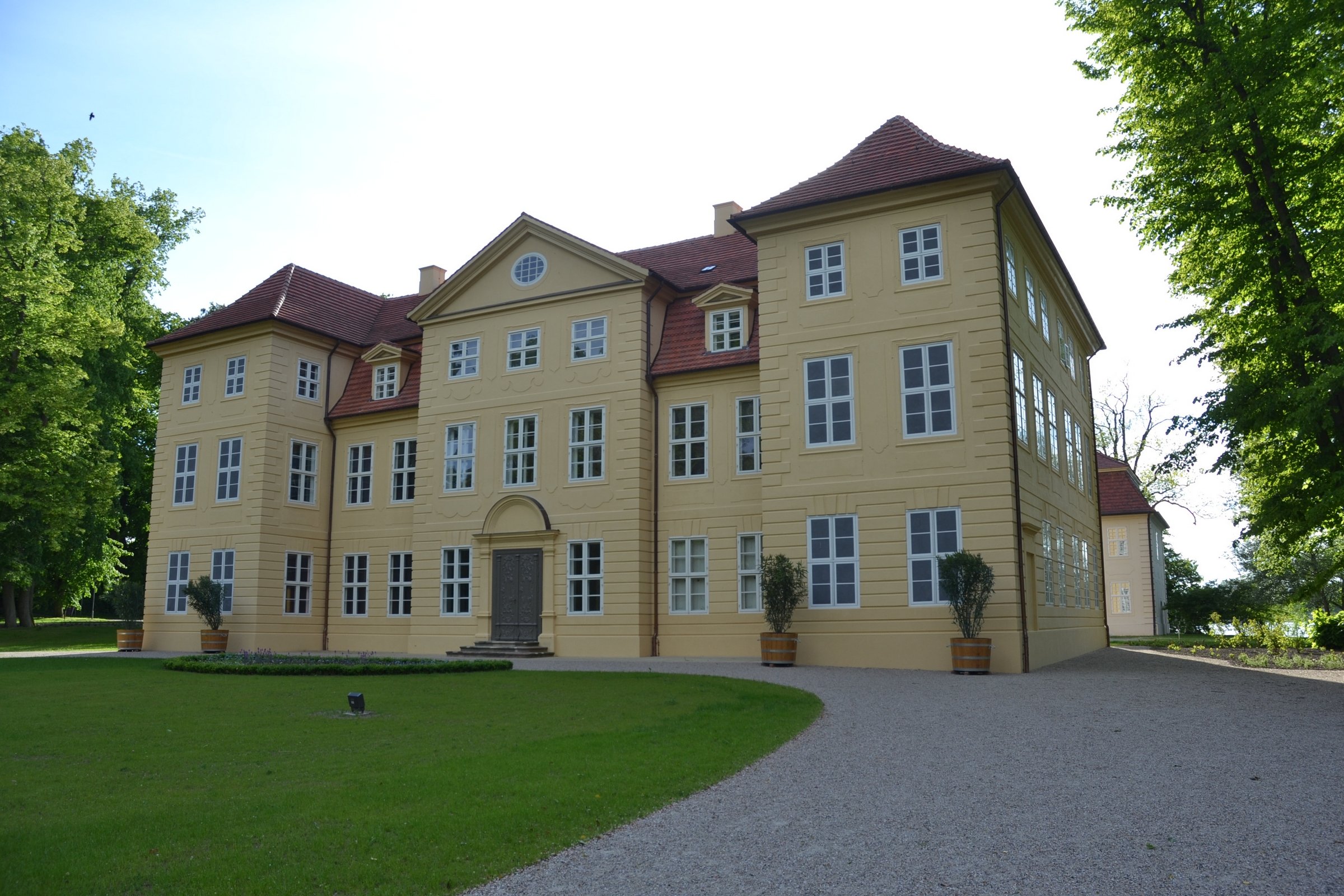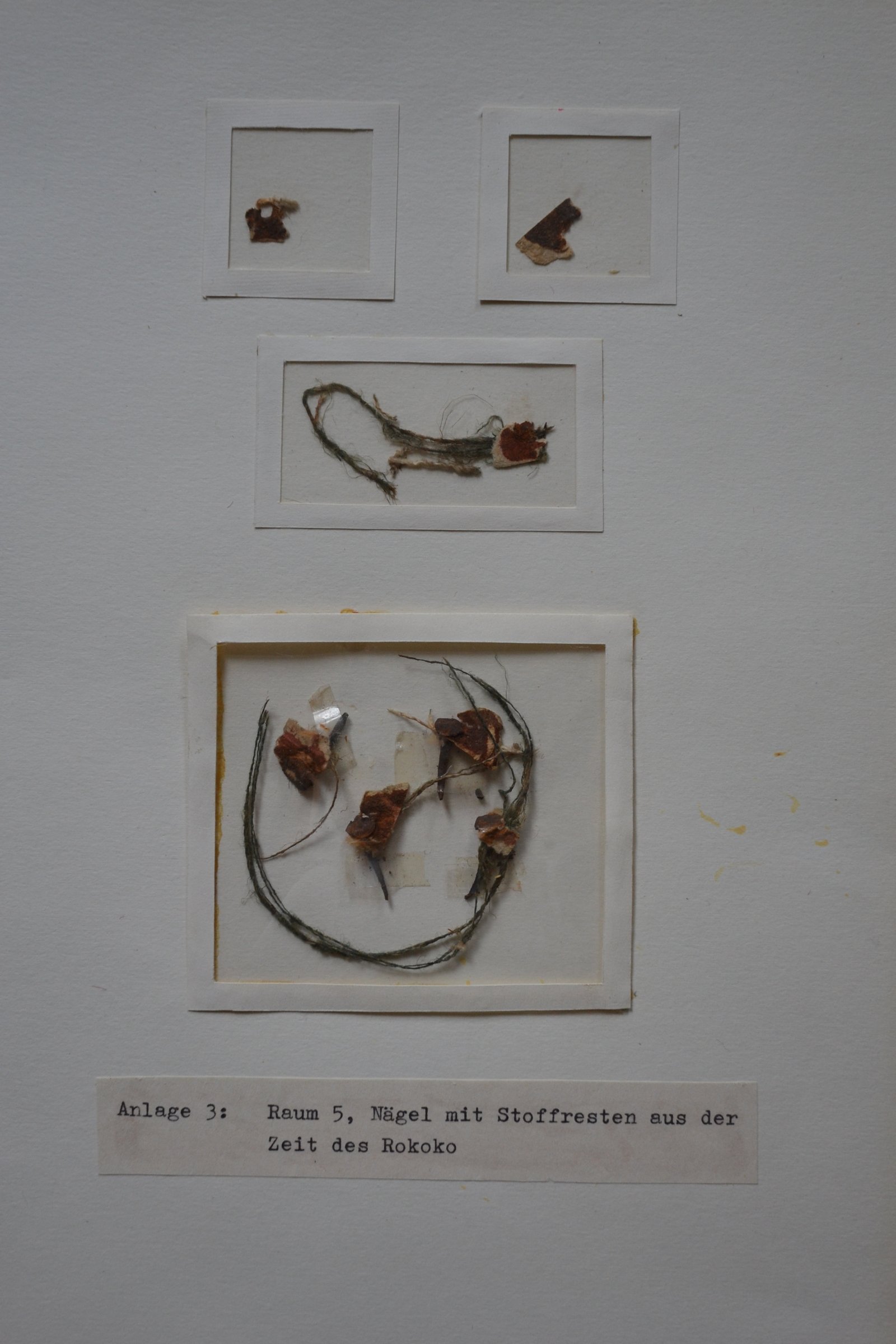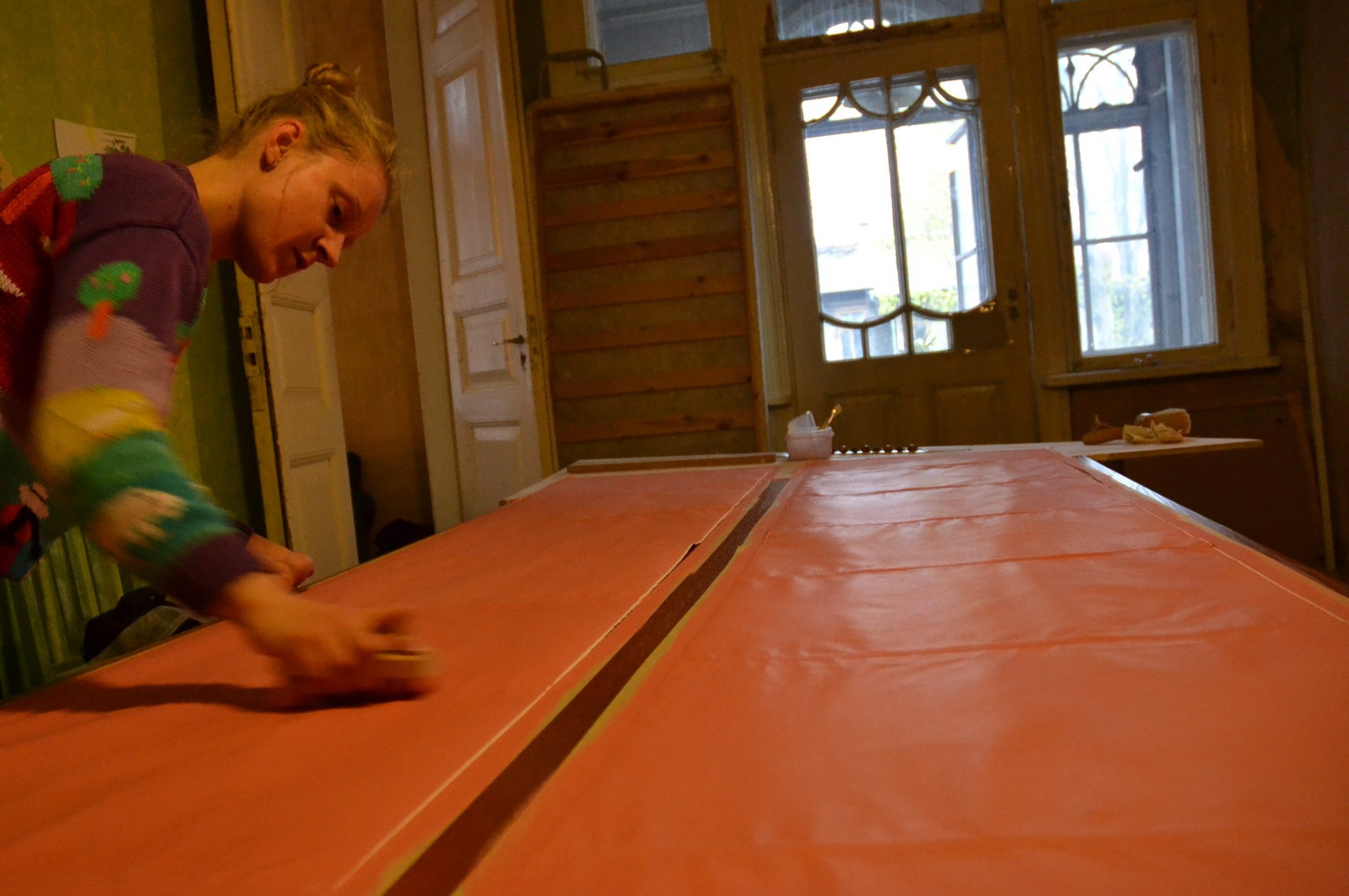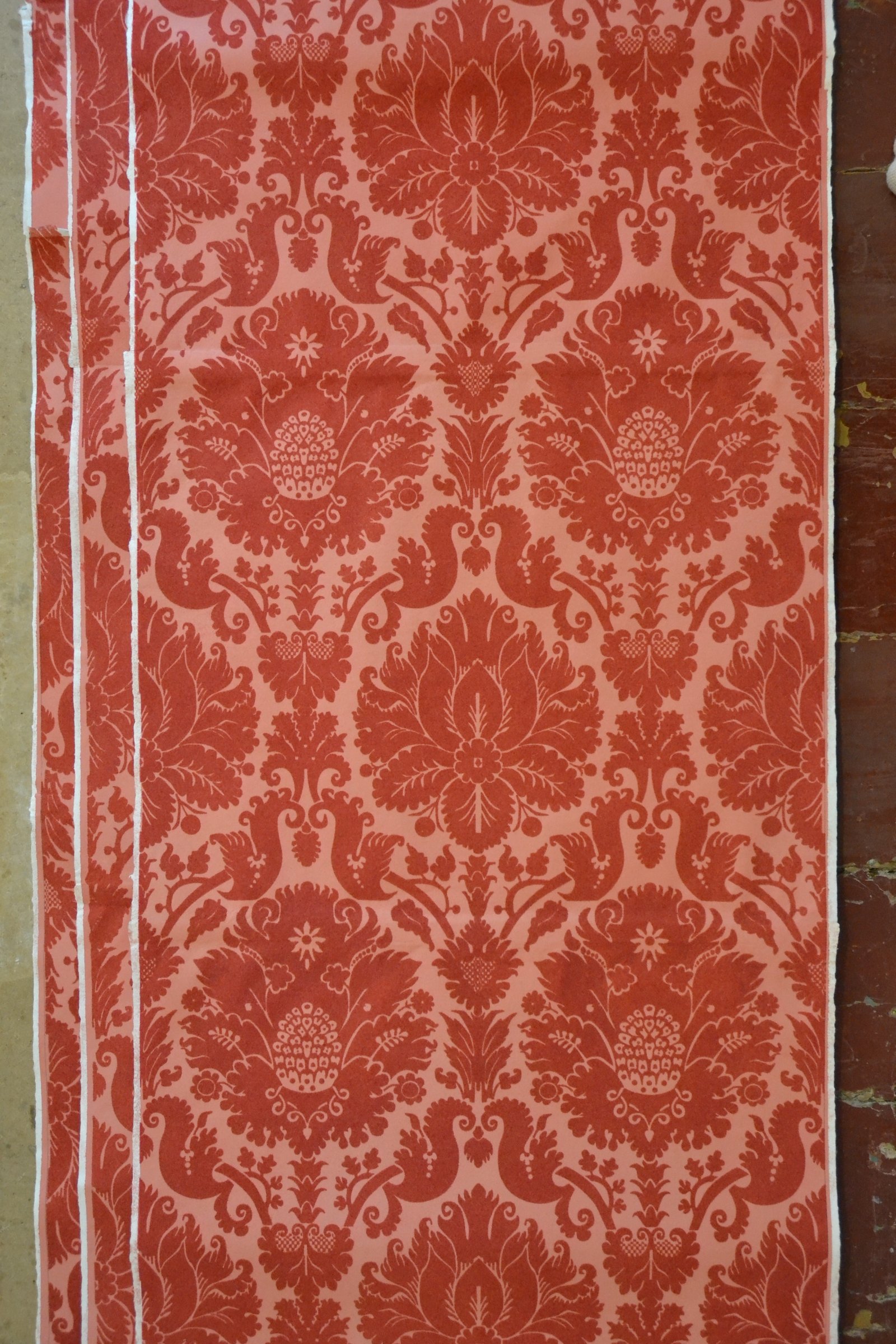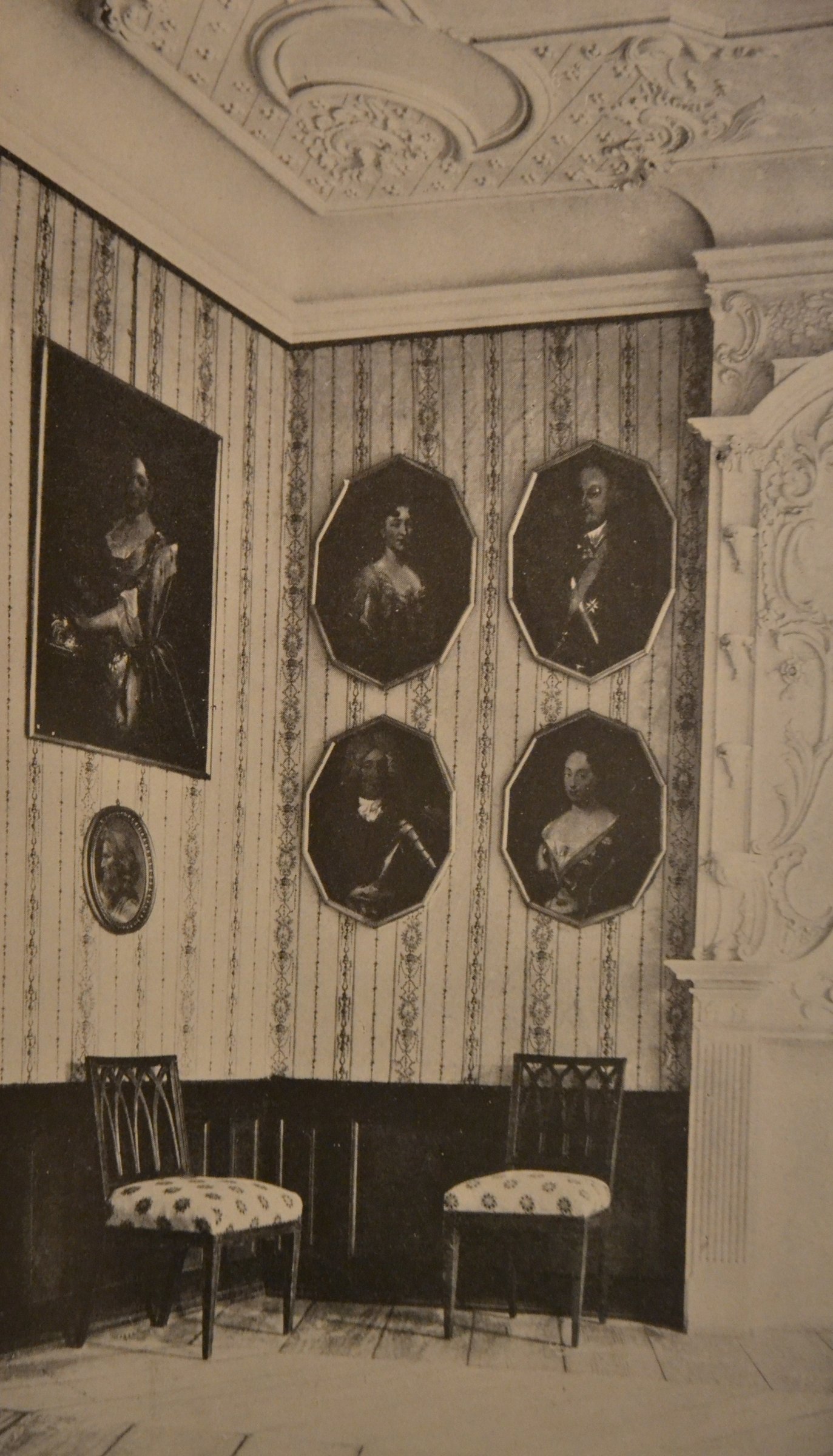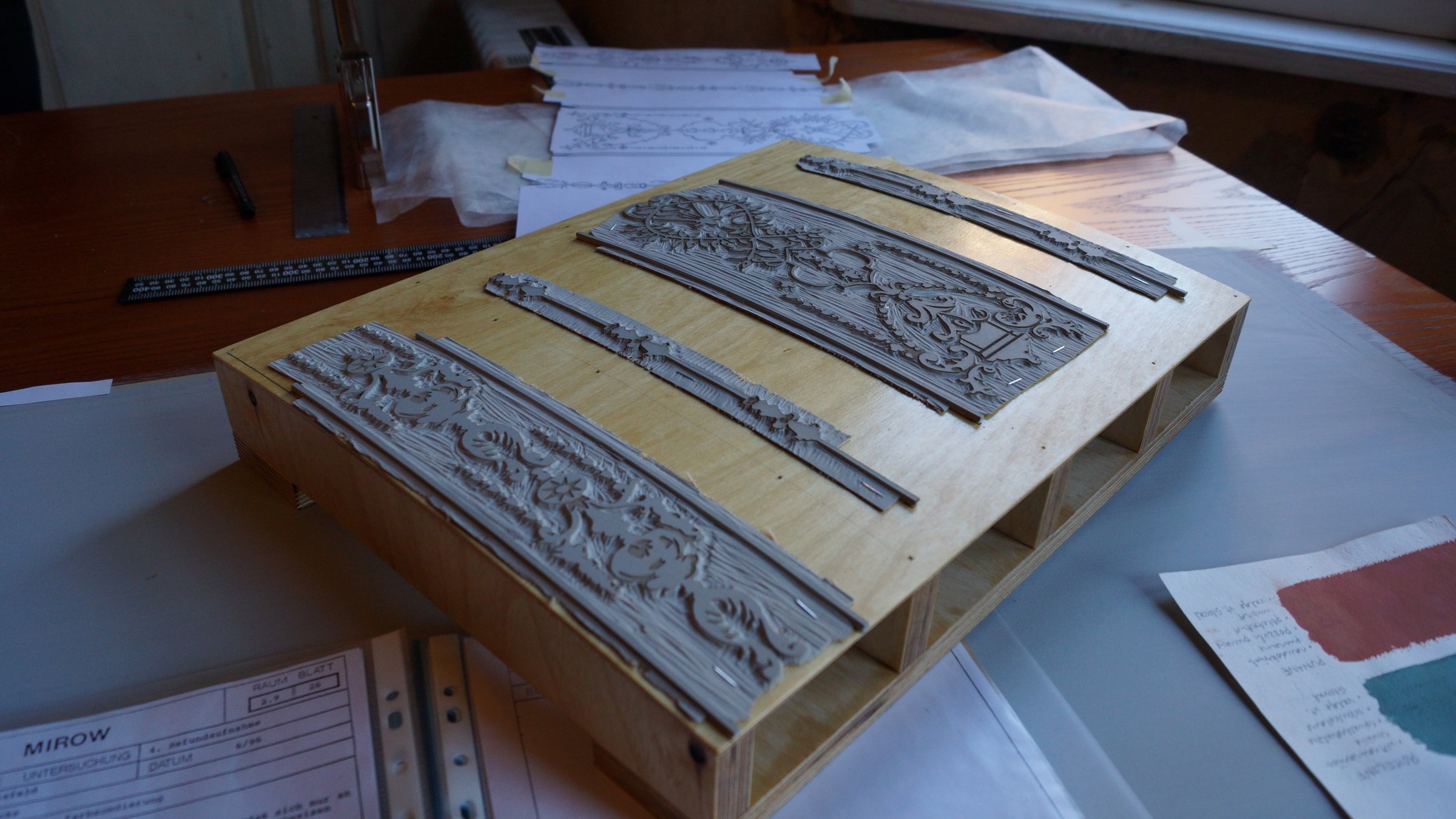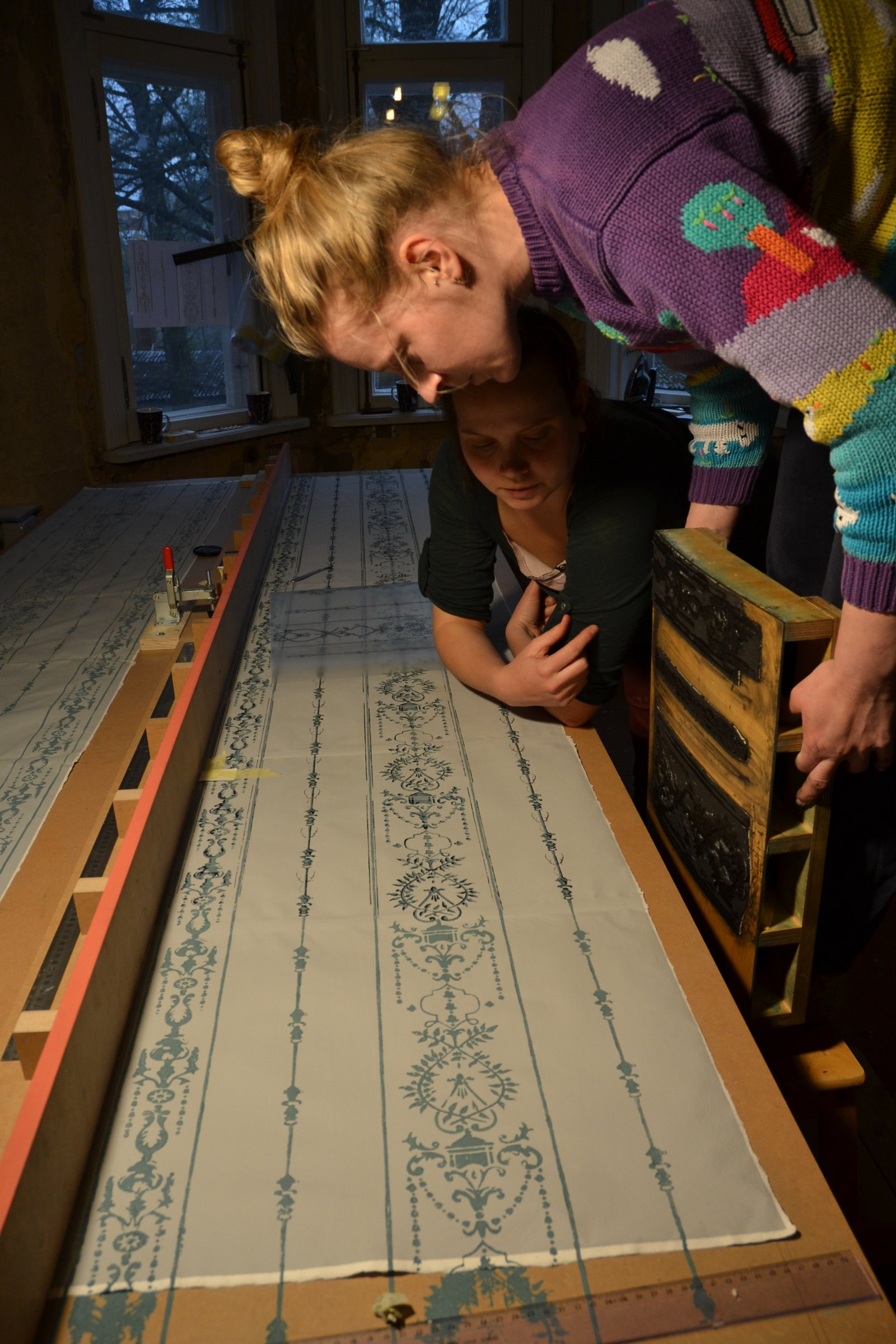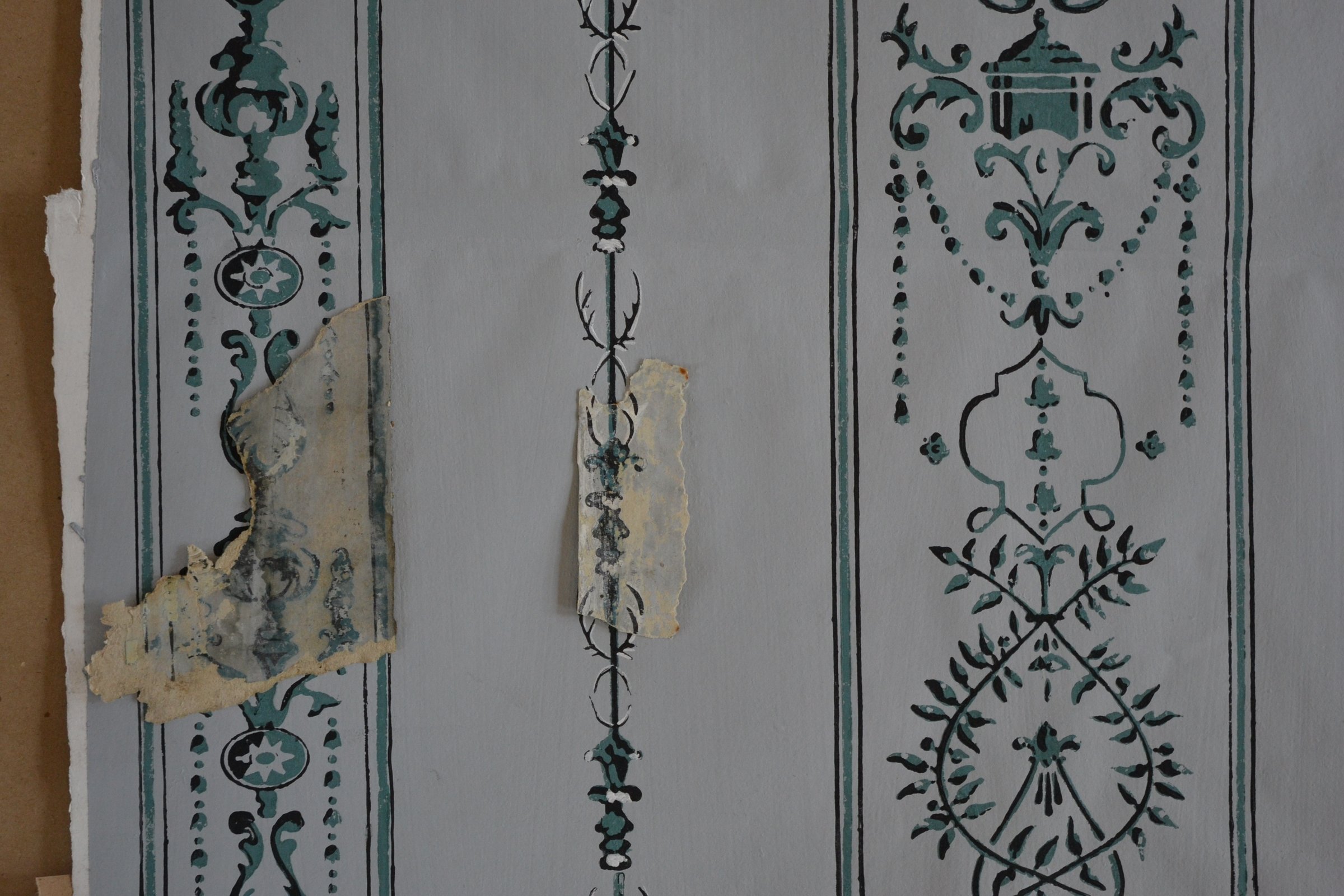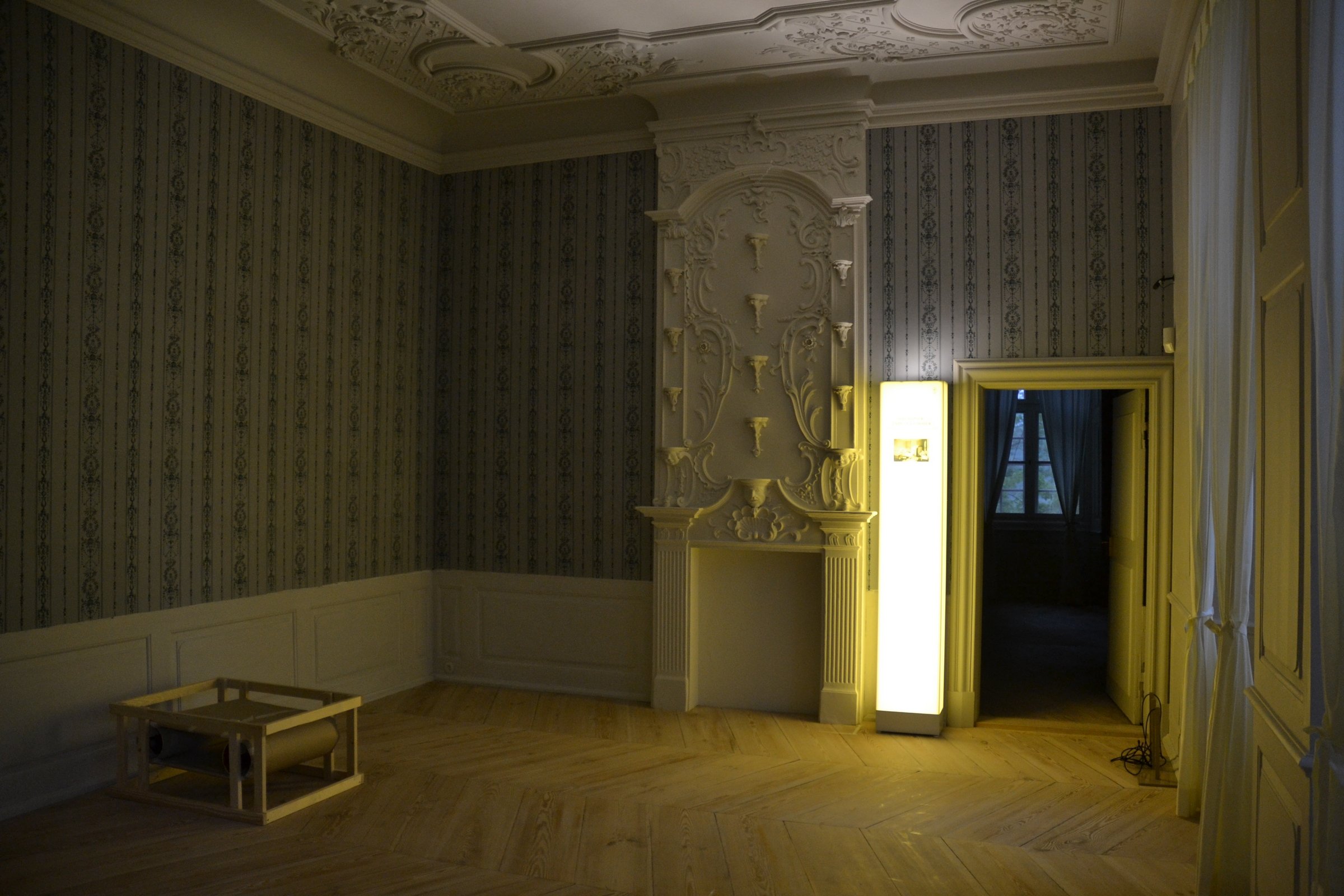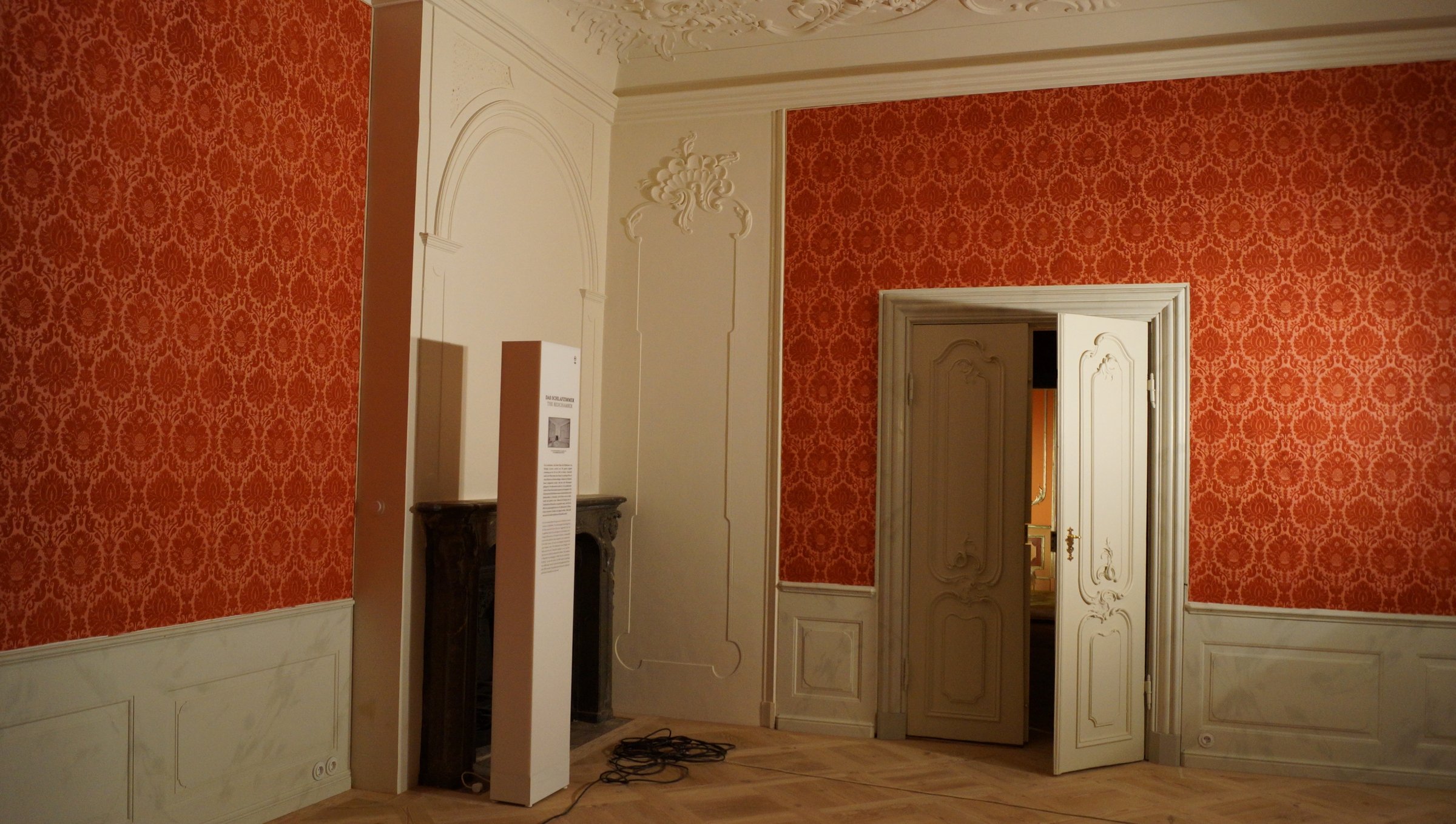THE RECONSTRUCTION STORY OF TWO WALLPAPERS IN MIROW PALACE
Autor:
Kadri Kallaste
Year:
Anno 2015
Category:
Conservation
In the summer of 2013 a competition for finding re-constructors to work on two wallpapers in Mirow Palace – a baroque palace in the Mecklenburg-Vorpommern state was announced. The Revaler Tapeten OÜ, an enterprise focusing on restoration and reproduction of historical wallpapers, entered the competition and was selected. The aim of the project was to reconstruct two historical wallpapers as exact as possible to the original, using old printing techniques and materials. Such a complicated assignment was too much for the enterprise to shoulder alone, so a team of various specialists was made up and as the result of the collaboration two rooms in Mirow Palace were restored in their original glory.
Mirow Palace is located on an island in the lake of the same name, in the town called Mirow in the Mecklenburg-Vorpommern state, Germany. The palace in its landscaped park, together with a cavaliers’ house, palace chapel, stable-cum-coach-house and gate tower combine an architectural and art-historical ensemble, erected in 1709-1711. The majority of the rooms date from the period when the widowed duchess Elisabeth Albertine zu Mecklenburg-Sterlitz (1713-1761) and her children used to live in the palace.
Extensive construction works in the palace began in 1753. In the course of short time quite a few noteworthy rococo interiors were created. Some masters working in Mirow had earlier been employed by the King of Prussia, Friedrich II (1712-1786). When Prussia was dragged into the Seven-year War in 1756, many of them lost their income and masters who had worked for the best residences in Berlin and Potsdam, were forced to find employment outside Prussia. Many of them found it in Mirow Palace.
The zu Mecklenburg-Strelitz family owned Mirow Palace until its expropriation in 1918. After that it used to serve for different functions and in the course of the time several historical interiors were changed and badly damaged.
In 1993 the palace-ensamble was taken over by the local municipality of the Mecklenburg-Vorpommern state. Since then it has been organising and financing restoration and reconstruction work in the palace. Extensive investigation and research on the historical wallfinishes was carried out in 1996. Most of the information needed for wallpaper reconstruction was provided by the research reports. Extensive restoration works, including the reconstruction of historical wallcoverings lasted up to June 2014, when the palace was opened for the public again.
The Revaler Tapeten OÜ was responsible for reconstructing two historical wallpapers dating from different periods. The older – a red flock wallpaper dated back to the mid-18th century, when the above-mentioned extensive renovation took place. The red wallpaper had covered the bedroom walls of Duchess Elisabeth Albertine. Of the initial wallpaper only tiny fragments barely covering a fingertip, were found during the study of the interiors., However they were enough to inform the team about the printing technique, shades of the pattern and the materials used. It turned out that it had been two-toned flock wallpaper with light madder-coloured background and darker madder-coloured velvety ornament. As these tiny fragments had been found hanging on the wall with iron nails and strips of canvas, it was clear the original wallpaper had been first glued on canvas and then mounted on the walls along the perimeters of the room. The scraps were too small to determine the whole pattern repeat and thus the fragments a historical green half-silk found in the cavaliers’ house were chosen as a model for the pattern. The team felt justified to do it, as the fragments originated from an auxiliary building belonging to the ensable and dated from the same period. As the pattern on the half-silk fragments had not completely preserved, a reconstructed pattern Brocatell Schloss Köthen produced by the silk manufactory Eschke was chosen instead.
For printing the flock wallpaper dyed and finely ground wool was used. The grinding was done at the Goonvean Fibres Ltd. company in England. The paper was produced by the Maris Paper Studio OÜ that is focused on manufacturing rag paper. The sheets were handed over to the project leader Kristiina Ribelus from Tartu Restauraator OÜ, who arranged a team for wallpaper printing. The first task was to join the sheets into wallpaper strips. The background was sized with casein paint, as the surface of the background had to be satined. A glue needed for binding the finely grained wool dust was printed on the paper with a serigraphy frame that enables small and complicated patterns to be printed.
Another, a grey wallpaper dated from the early 19th century, possibly from the 1810s. The wallpaper had covered the walls in a first-floor room that was earlier used as an ancestors’ gallery – a memorial room for the duke’s family. This wallpaper had a bluish-grey background ornamented with three different-sized vertical strips that could be rather classified as late-Classicist not as early 19th-century Biedermeier pattern.
Only three small fragments of the original wallpaper had preserved but they provided the team with enough information for determining the size and the tones of the pattern. The background was bluish-grey and the pattern printed with black, white and bluish-green. In addition to the fragments the team was provided with several documents and photos made during the research in 1996 and three historical black and white photos. The oldest of the latter dated from 1913-1914. As the original could not be found the team used a photo published in Jürgen Brandt’s book Alt-Mecklenburgische Schlösser und Herrensitze (1925). The other two DIA photos dated from the post-Second World War time, 1949-1952.
Out of three vertical strips two smaller ones could be reconstructed using the historical fragments. The third and the largest one had to be reconstructed according to the historical photos. The paper was produced by the Maris Paper Studio OÜ in Tallinn.
Although the original wallpaper had been printed with wooden blocks, linocut was chosen to save some time. Both techniques leave a similar mark on paper, however linocut blocks wear down faster. For printing the wallpapers of Mirow palace a three-millimetre-thick graphic artists’ linoleum was used. The pattern was cut into it with laser. The cut linoleum was laid on a wooden and plywood base that was slightly bent to make printing easier. Two of the ornaments – black and bluish-green were printed with linocut blocks; the white details were hand-painted. As wished by the costumer, the wallpaper was mounted by the team itself.
THE TEAM OF THE MIROW PROJECT:
Grey wallpaper. Drawing the pattern – Greg Clark, Kristiina Ribelus, Kadri Kallaste
Red flock wallpaper. Reconstruction of the I pattern – Greg Clark, Kadri Kallaste
Red flock wallpaper. Drawing of the II pattern – Kadri Toom
Rag-paper production – Maris Allik, the Maris Paper Studio OÜ
Wallpaper printing – Tartu Restauraator OÜ. Project manager – Kristiina Ribelus. Project team – Kadri Toom, Pille Vilgota, Erle Kaur
Assistant manager – Viljar Vissel (SA EVM Conservation and Digitisation Centre Kanut)
Transport and mounting – Kristiina Ribelus, Kadri Toom, Pille Vilgota, Kadri Kallaste, Bertil Tüvi
Many thanks to our advisors Heige Peets (SA EVM Conservation and Digitisation Centre Kanut) and Anne Rudanovski (Printing Museum and Paper Museum)
REFERENCES:
Tellija hinnapakkumise tekst. Preisanfrage. Betrieb für Bau und Liegenschaften Mecklenburg-Vorpommern. Geschäftsbereich Schwerin. Projekt-Nr. 17051E70001

